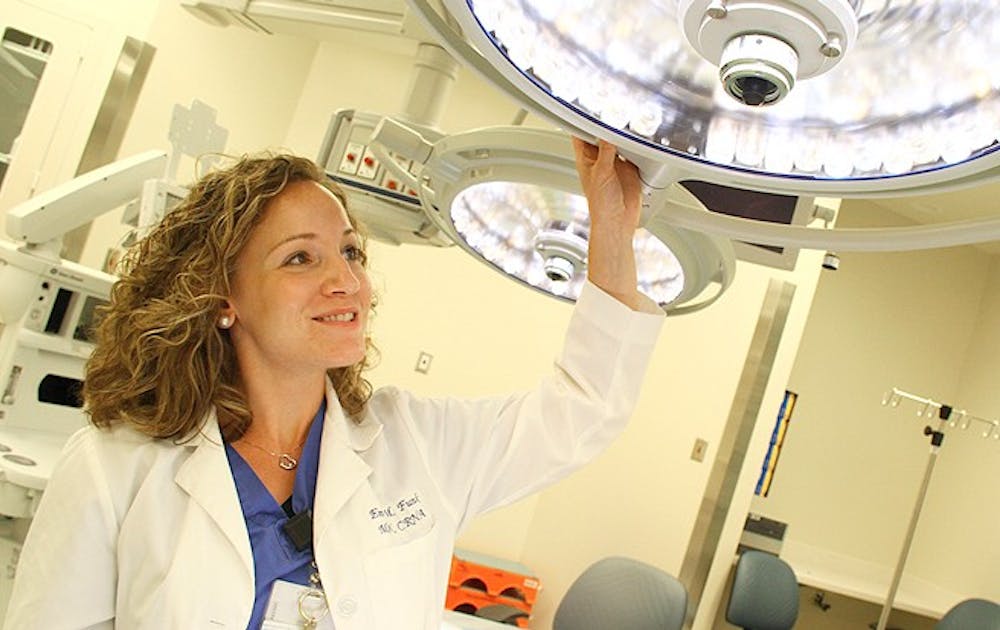After three and a half years and nearly $600 million, Duke Hospital’s glass-walled Medical Pavilion opened its doors to the public this weekend.
The building opens for patients July 29, but visitors young and old toured the facility Saturday, wandering through art-lined hallways to view state-of-the-art medical units. The pavilion will introduce new medical technologies and expand the patient capacity of the hospital. With more patients seeking treatment in the Medical Pavilion, Duke North’s operating rooms will be able to undergo incremental renovations.
“To be successful long term we need to create the right space [where] people can work together and succeed,” said Victor Dzau, chancellor for health affairs and president and CEO of the Duke University Health System. “Now we have a wonderful place, and a very uplifting environment to work with.”
The pavilion adds 44 pre-operation bays and 18 operation rooms to Duke North’s 69 pre-op bays and 37 operating rooms, said Duchess Diard, clinical operations director for the Peri-Anesthesia Care Unit. The new units are generally bigger and have more advanced technology than the older facility. For example, a patient lying in the new pre-op bays will have their vitals monitored and connected to the nurse’s phone, so the nurse can respond quickly if there are any sudden changes.
The new bays will allow for sections of Duke North to be taken offline for renovations and updates in the coming years, Diard said. In the meantime, the brand new bays will likely be prioritized for patients with more complicated medical histories.
The new operating rooms condense the necessary equipment into mechanical arms that drop down from the ceiling. Doctors can easily reposition these arms throughout the room as needed, and they contain their own power source, eliminating the need for power cables snaking across the floor.
Surgeons also now have access to an intraoperative MRI machine in two of the operating rooms, which shows detailed images of the body’s interior while the patient is undergoing an operation.
This will be especially useful in brain and spine surgery, said Certified Registered Nurse Anesthetist Lisa Tatko. It will allow doctors to see how the surgery is going before the patient wakes up, and could decrease the need for a second surgery.
“That’s groundbreaking,” she added.
Even the more simple tools have gotten an upgrade. The operating room lights are now a ring of LED diodes that can be adjusted based on the physician’s preference, sporting low energy usage and heat emissions, said Certified Resgistered Nurse Anesthetist Emily Funk.
“It gets hot for surgeons—they’re draped in sterile clothes, the patients give off heat… These [lights] are much more comfortable for doctor and patient,” Funk said.
Architecturally, the building fits closely with the glass and steel style of the recently opened Mary Biddle Duke Trent Semans Center For Health Education and the Cancer Center. The pavilion’s nine stories are decked out with floor-to-ceiling windows that flood the interior with sunlight.
For David May, a retired clinical social worker from Duke’s neuro-intensive care unit, this is a welcome update from the small windows and concrete that dominate the architecture of Duke North.
“This is a new concept in terms of hospital buildings, this glass from ceiling to floor,” May said. “Everywhere you look there’s sunlight.”
Just inside the walls of windows, the waiting rooms have a cozy interior. Carpets line the floors, and expansive canvases, many of them landscapes of North Carolina’s beaches and forests by locals artists, lend color to the walls.
For May, who used to counsel families on the life-changing events that tend to precede ICU treatment, the new building offers many more comfortable and quiet spots where families can gather for a conference with their doctor or counselor.
Visitors and patients can watch flat screen TVs while sitting back in rocking chairs and fully reclining armchairs, taking in the panoramic view that spans from Duke Medicine Circle to Duke Chapel and the forests beyond. The reclining chairs felt like “being on a cloud,” said Durham resident Josue Jenkin.
“Oh my goodness—I’ve never been in a reception room like this,” she remarked.
Get The Chronicle straight to your inbox
Signup for our weekly newsletter. Cancel at any time.

